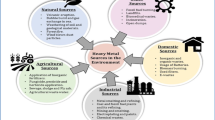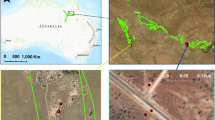Abstract
Absorption, accumulation and translocation of 12 trace elements in nine dominant mangrove plants in the Indian Sundarban Wetland revealed both organ-specific and site-specific characteristics. An overall enrichment of elements was recorded in rhizosediment, exceeding the prescribed effects range-low (ER-L) of consensus based sediment quality guidelines (SQGs) for Cu and Pb. Avicennia officinalis, A. alba, Ceriops decandra and Excoecaria agallocha exhibited unique potential for accumulating Al, Cd, Co, Cr, Cu, Ni, Mn and Zn and could be considered efficient accumulators. Maximum element accumulation in trunk bark (As 6.16, Cr 49.9, Co 2.67, Cu 91.00 and Zn 85.5 mg kg−1) and root/pneumatophore (Al 1000 and Fe 2430 mg kg−1) was recorded. Maximum bioconcentration factor (6.23) in A. officinalis and translocation factor (17.5 for Mn) in C. decandra distinguished their phytoremediation capacity. These halophytes could be used for trace element phytoremediation in stressed sites of Sundarban.



Similar content being viewed by others
References
Abrahim GM, Parker RJ (2008) Assessment of heavy metal enrichment factors and the degree of contamination in marine sediments from Tamaki Estuary, Auckland, New Zealand. Environ Monit Assess 136(1–3):227–238
Bhattacharya BD, Bhattacharya AK, Rakshit D, Sarkar SK (2014) Impact of tropical cyclonic storm “Aila” on the water quality characteristics and mesozooplankton community structure of Sundarban wetland, India. Indian J Geomarine Sci 43 (2):216–223
Chakraborty D, Bhar S, Majumdar J, Santra SC (2013) Heavy metal pollution and phytoremediation potential of Avicennia officinalis L. in the southern coast of the Hoogly estuarine system. Int J Environ Sci 3(6):2291–2303
Chaudhuri SK, Lack JG, Coats JD (2013) Biogenic magnetite formation through anaerobic biooxidation of Fe (II). App Environ Microbiol 67(6):2844–2848
Chen Y, Li X, Shen Z (2004) Leaching and uptake of heavy metals by ten different species of plants during an EDTA-assisted phytoextraction process. Chemosphere 57:187–196
Chowdhury R, Favas PJC, Pratas J, Jonathan MP, Sankar Ganesh P, Sarkar SK (2015) Accumulation of trace elements by mangrove plants in Indian Sundarban Wetland: prospects for phytoremediation. Int J Phytorem 17(9):885–894
de Vallejuelo SFO, Barrena A, Arana G, de Diego A, Madariaga JM (2009) Ultrasound energy focused in a glass probe: an approach to the simultaneous and fast extraction of trace elements from sediments. Talanta 80:434–439
de Vallejuelo SFO, Arana G, de Diego A, Madariaga JM (2010) Risk assessment of trace elements in sediments: the case of the estuary of the Nerbioi-Ibaizabal River (Basque Country). J Haz Mat 181:565–573
Folk RL, Ward WC (1957) Brazos River bar: a study of the significance of grain size parameters. J Sediment Petrol 27:3–26
Friedman GM, Sanders JE (1978) Principles of sedimentology. John Wiley, New York
Gabriel AVS, Salmo SG III (2014) Assessment of trace element bioaccumulation by Avicennia marina (Forsk.) in the last remaining mangrove stands in Manila Bay, the Philippines. Bull Environ Contam Toxicol 93:722–727
Gupta S, Chakrabarti SK (2013) Effect of heavy metals on different anatomical structures of Bruguiera sexangula. Int J Bio-Res Stress Manage 4(4):605–609
Harbison P (1986) Mangrove muds: a sink and a source for trace metals. Mar Pollut Bull 17:246–250
Jonathan MP, Sarkar SK, Roy PD, Alam Md A, Chatterjee M, Bhattacharya BD, Bhattacharya A, Satpathy KK (2010) Acid-leachable trace metals in sediment cores from Sunderban Mangrove Wetland, India: an approach towards regular monitoring. Ecotoxicology 19:405–418
Kathiresan K, Saravanakumar K, Sahu SK, Sivasankaran M (2014) Adenosine deaminase production by an endophytic bacterium (Lysinibacillus sp.) from Avicennia marina. Biotech 4(3):235–239
Krumbein WC, Pettijohn FJ (1938) Manual of sedimentary petrography. Appleton-Century, New York
Laureysens I, Blust R, De Temmerman L, Lemmens C, Ceulemans R (2004) Clonal variation in heavy metal accumulation and biomass production in a poplar coppice culture: I. Seasonal variation in leaf, wood and bark concentrations. Environ Pollut 131:485–494
Li H, Wang Y, Zhu W, Xu Q, He Y, Tang W, Zhuo H, Wang D, Wu J, Li D (2013) Seismic characteristics and processes of the Plio-Quaternary unidirectionally migrating channels and contourites in the northern slope of the South China Sea. Mar Petrol Geol 43:370–380
Long ER, MacDonald DD, Smith SL, Calder FD (1995) Incidence of adverse biological effects within ranges of chemical concentrations in marine and estuarine sediments. Environ Manage 19:81–97
MacDonald DD, Carr RS, Calder FD, Long ER, Ingersoll CG (1996) Development and evaluation of sediment quality guidelines for Florida coastal waters. Ecotoxicology 5:253–278
MacFarlane GR, Pulkownik A, Burchett MD (2003) Accumulation and distribution of heavy metals in grey mangrove, Avicennia marina (Forsk) Vierh-Biological Indication Potential. Environ Pollut 123:139–151
Mandal RN, Naskar KR (2008) Diversity and classification of Indian mangroves: a review. Trop Ecol 49(2):131–146
Müller G (1981) Die Schwerelementlbelstung der sedimente des Neckars und seiner Nebenflusse: eine Bestandsaufnahme. Chem Zeitung 105:157–164
Nowrouzi M, Pourkhabbaz A (2014) Application of geoaccumulation index and enrichment factor for assessing metal contamination in the sediments of Hara Biosphere Reserve, Iran. Chem Spec Bioavailab 26(2):99
Phaenark C, Pokethitiyook P, Kruatrachue M, Ngernsansaruay C (2009) Cd and Zn accumulation in plants from the padaeng zinc mine area. Int J Phytorem 11:479–495
Pulford ID, Watson C (2003) Phytoremediation of heavy metal contaminated land by trees—a review. Environ Int 29:529–540
Salamova A, Hites RA (2012) Brominated and chlorinated flame retardants in tree bark from around the globe. Environ Sci Techn 47(1):349–354
Sheue CR, Liu HY, Tsai CC, Rashid SMA, Yong JWH, Yang YP (2009) On the morphology and molecular basis of segregation of two species Ceriops zippeliana Blume and C. decandra (Griff.) Ding Hou (Rhizophoraceae) from southeastern Asia. Blumea 54:220–227
Souza LDC, Rocha LD, Morozesk M (2015) Changes in bioaccumulation and translocation patterns between root and leaves of Avicennia schaueriana as adaptive response to different levelsof metals in mangrove system. Mar Poll Bull 94:176–184
Thomas G, Fernandez T (1997) Incidence of heavy metals in the mangrove flora and sediments in Kerala, India. Hydrobiologia 352:77–87
Tomlinson PB (1986) The Botany of Mangroves. Cambridge University Press, Cambridge
Untawale AG, Wafer S, Bhosale NB (1980) Seasonal variation in heavy metal concentration in mangrove foliage. Mahasagar 13: 215–223
Usman ARA, Mohamed HM (2009) Effect of microbial inoculation and EDTA on the uptake and translocation of heavy metals by corn and sunflower. Chemosphere 76:893–899
Usman ARA, Alkreda RS, Al-Wabel MI (2013) Heavy metal contamination in sediments and mangroves from the coast of Red Sea: Avicennia marina as potential metal bioaccumulator. Ecotoxicol Environ Saf 97:263–270
Veerasingam S, Vethamony P, Mani Murali R, Fernandes B (2015) Depositional record of trace metals and degree of contamination in core sediments from the Mandovi estuarine mangrove ecosystem, west coast of India. Mar Pollut Bull 91(1):362–367
Walkey A, Black TA (1934) An examination of the Dugtijaraff method for determining soil organic matter and proposed modification of the chronic and titration method. Soil Sci 37:23–38
Wang Y, Qiu Q, Xin G, Yang Z, Zheng J, Ye Z, Li S (2013a) Heavy metal contamination in a vulnerable mangrove swamp in South China. Environ Monit Assess 185:5775–5787
Wang ZH, Feng J, Jiang T, Gu YG (2013b) Assessment of metal contamination in surface sediments from Zehlin Bay, the South China Sea. Mar Pollut Bull 76:383–388
Watts MJ, Barlow TS, Button M, Sarkar SK, Bhattacharya BD, Alam MA, Gomes A (2013) Arsenic speciation in polychaetes (Annelida) and sediments from the intertidal mudflat of Sundarban mangrove wetland, India. Environ Geochem Health 35:13–25
Zhou YW, Peng YS, Li XL, Chen GZ (2011) Accumulation and partitioning of heavy metals in mangrove rhizosphere sediments. Environ Earth Sci 64:799–807
Acknowledgments
This study was sponsored jointly by Council of Scientific and Industrial Research (CSIR), India (Sanction number 38 (1296)/11/EMR-II) and SUDOE Interreg IV B programme through the ORQUE SUDOE 611 (Ref. SOE3/P2/F591/5) Project and the Basque Government through Consolidated Research 612 Group Project 2013–2018 (Ref. IT-742-13). Ranju Chowdhury, one of the coauthors, expresses sincere thanks to CSIR for extending her fellowship. A. Rodriguez, the first author of the paper, is grateful to the UPV/EHU for his pre-doctoral fellowship.
Author information
Authors and Affiliations
Corresponding author
Rights and permissions
About this article
Cite this article
Rodríguez-Iruretagoiena, A., Chowdhury, R., Gredilla, A. et al. Uptake and Distribution of Trace Elements in Dominant Mangrove Plants of the Indian Sundarban Wetland. Bull Environ Contam Toxicol 97, 721–727 (2016). https://doi.org/10.1007/s00128-016-1919-z
Received:
Accepted:
Published:
Issue Date:
DOI: https://doi.org/10.1007/s00128-016-1919-z




